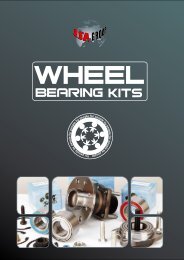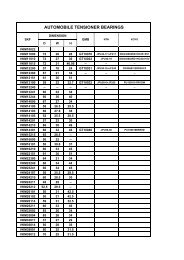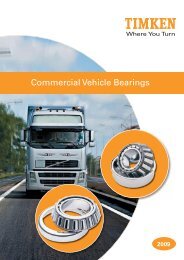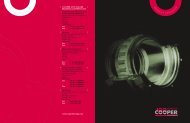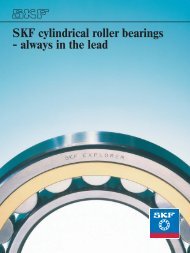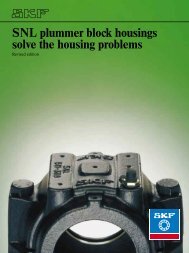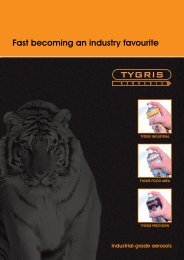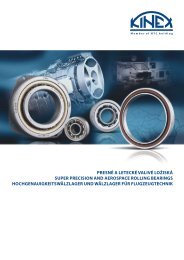CARB® toroidal roller bearings â a revolutionary ... - Acorn Bearings
CARB® toroidal roller bearings â a revolutionary ... - Acorn Bearings
CARB® toroidal roller bearings â a revolutionary ... - Acorn Bearings
Create successful ePaper yourself
Turn your PDF publications into a flip-book with our unique Google optimized e-Paper software.
1 Product information 2 Recommendations 3 Product data<br />
Page ............. 3 System life Page ............. 37<br />
Selection of bearing size<br />
To calculate bearing size or the basic<br />
rating life for a <strong>toroidal</strong> <strong>roller</strong> bearing<br />
it is possible to use all the known and<br />
standardized (ISO 281) calculation<br />
methods. However, it is recommended<br />
that the SKF Life Method be applied<br />
so that the enhanced performance of<br />
SKF <strong>bearings</strong> can be fully exploited.<br />
Detailed information can be found in the<br />
SKF General Catalogue in the section<br />
“Selection of bearing size” or in the<br />
“SKF Interactive Engineering Catalogue”<br />
available on CD-ROM or online<br />
at www.skf.com.<br />
For a self-aligning bearing system<br />
that uses an SKF Explorer spherical<br />
<strong>roller</strong> bearing and a CARB bearing,<br />
system life can be calculated using the<br />
SKF rating life equation:<br />
L nm,Sys =<br />
9/8<br />
where<br />
L nm,Sys<br />
L nm,SRB<br />
L nm,CARB =<br />
1<br />
L nm,SRB<br />
9/8<br />
= SKF rating life for the bearing<br />
system (at 100 – n %<br />
reliability), millions of revolutions<br />
= SKF rating life for the locating<br />
spherical <strong>roller</strong> bearing<br />
(at 100 – n % reliability),<br />
millions of revolutions<br />
SKF rating life for the nonlocating<br />
CARB <strong>toroidal</strong><br />
<strong>roller</strong> bearing (at 100 – n %<br />
reliability), millions of revolutions<br />
1<br />
+<br />
1<br />
L nm,CARB<br />
9/8<br />
Longer life or downsizing<br />
When used in a self-aligning bearing<br />
system, the CARB bearing prevents<br />
internally induced axial forces from<br />
occuring. This is in contrast to conventional<br />
self-aligning bearing systems<br />
with two spherical <strong>roller</strong> <strong>bearings</strong> or<br />
self-aligning ball <strong>bearings</strong> where the<br />
induced internal axial forces can be<br />
20 % or more of the radial load acting<br />
on the non-locating bearing. These<br />
additional forces represent a sizeable<br />
proportion of the total load that cannot<br />
be neglected and can result in<br />
• the bearing system not achieving the<br />
requisite life, or<br />
• larger <strong>bearings</strong> being used to compensate<br />
for the additional forces.<br />
Because a CARB <strong>toroidal</strong> <strong>roller</strong> bearing<br />
prevents internally induced axial<br />
forces from occuring, the load conditions<br />
in the bearing arrangement can<br />
be predicted accurately since the<br />
locating bearing is only subjected to its<br />
portion of the external radial and axial<br />
loads, while the non-locating bearing<br />
is only subjected to its portion of the<br />
radial load.<br />
Whether a spherical <strong>roller</strong> bearing<br />
(➔ diagram 1 ) or a self-aligning ball<br />
bearing (➔ diagram 2 ) is used in the<br />
locating position, the new self-aligning<br />
bearing system can substantially<br />
increase the service life of a bearing<br />
arrangement. It is also worth noting<br />
that, even if smaller <strong>bearings</strong> are used,<br />
it is often possible to achieve system<br />
lives that are longer compared to the<br />
traditional systems. This can be<br />
exploited by downsizing adjacent<br />
components and reducing costs.<br />
To take full advantage of the benefits<br />
offered by the new self-aligning<br />
system it is necessary to carefully<br />
select the bearing size – at the nonlocating<br />
as well as the locating side.<br />
For assistance, contact the SKF application<br />
engineering service.<br />
12





